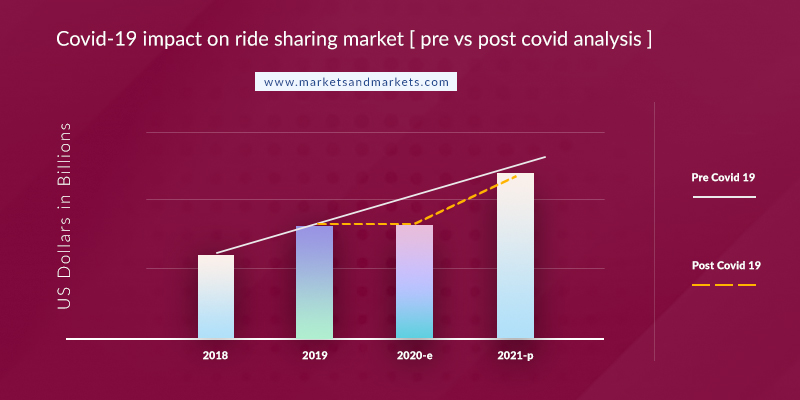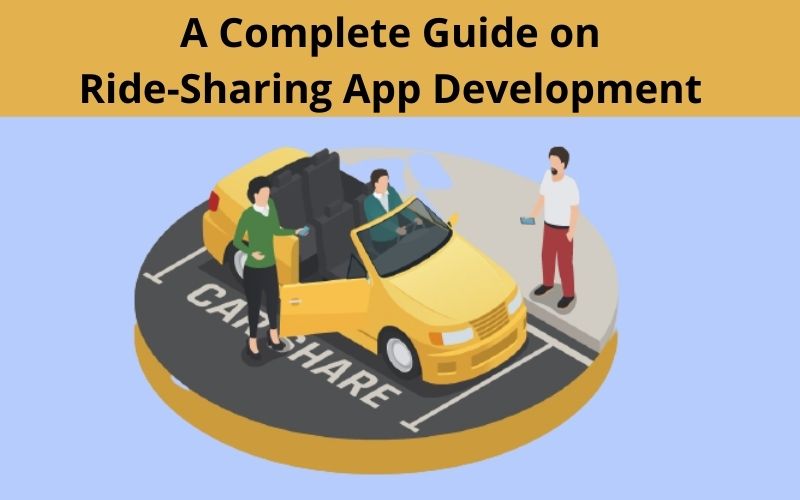A Complete Guide on Ride-Sharing App Development
For the last two decades, LiftShare has been making commute sustainable for the entire country. Following its lead, many more organisations like ZipCar and DriveNow have taken the stead and are now making this outstanding, eco-friendly, traffic-friendly, modern solution more and more ubiquitous.
And even though the unprecedented situations caused by COVID19 had impeded its growth, the ride-sharing market is still on the rise and is expected to witness a year-on-year growth of 55.6% by the end of the year 2021.

What more? Since now people are becoming more cognizant about the safety measures and mobility is on a constant rise, the market is expected to grow even more than before. This presents a perfect opportunity for businesses looking to invest in ride-sharing mobile app development. But before we get down to what the app does, let’s have a brief overview of its business model.
Car Sharing: The Environment-Friendly Business Model.
Ridesharing or car-sharing has been around since WWII when ‘car-sharing clubs’ were used as a tactic for rationing, wherein one neighbourhood council would encourage as many as four workers to share a ride in one automobile and divide the pay for the expenses. Later, the idea again gained more prominence during the consequent oil crisis.
Eventually, as more people got the purchasing power to own an automobile and traffic control became a major concern, authorities realised that car sharing can be much more than just a countermeasure. Later, the national charity Carplus took and promoted an initiative to reduce the economic, environmental, and social costs attached to the daily commute and car dependency.
Earlier, car sharing was only limited to specific neighbourhoods, where people would connect with their contacts and decide whether they wanted to carpool or not. However, now when the average distances covered by an automobile has increased, and so has the flow in traffic, a common solution has become the need of the hour; enters car-sharing apps.
Car sharing or ride-sharing apps are among the most popular utility mobile apps on App Store and Play Store. They allow registered users to enter the destination and origin source for their ride and then help them find if any of the driving users will be on the same route at the same time. If that happens, both the users (riders and drivers) can agree to ride together to enjoy reduced travel costs.
Most app owners in the industry take around 20% of the transportation charges paid by the rider, and the remaining 80% is directly disbursed to the driver. This way, all the parties involved get some value out of each transaction. The companies have also put data to good use to add another revenue source. Through real-time data analytics, the app can deduce the gap between demand and supply and surge the prices whenever there are more riders in an area than drivers. The cream amount here almost always ends up with the company. But how does an app manage to do all this?
How Does a Car Sharing App Work?
A car sharing mobile application is a utility app built to strengthen the sharing economy. The registered users on the app can either choose to be a rider or a driver. Thereafter, if they are a rider, they can enter their usual commute details, including origin source, destination, travel time, and vehicle capacity. After providing these details and other identification and security information, they can allow other users, the riders, to ride along them whenever all the other criteria match.
On the other hand, riders can also enter details of their regular and on-demand commute to see if there is any registered driver on the app going through the same route at the time. Since these shared rides are much cheaper (around 50% in most cases) than a taxi or a minicab fare, riders usually prefer to carpool whenever they have a chance.
With these two kinds of users registered, the function of the app can be segregated in the following steps-
Adding Journey Details
When a user first enters the app, they will be asked to enter the locations of the journey, both the destination and the origin. After that, they can enter the rest of the details, like whether it will be a one-time, regular, or a return journey. They can also provide time and date details for the trip. Once that’s done, the app will fetch details of all the other riders and drivers planning to go through a similar route at the same time.
Finding Co-riders
Once the list gets populated, the user can pick a rider or driver from amongst. They can even directly connect with all the other riders via direct chat to know the nature of the journey to make better decisions. Once both the parties agree to ride together, they can schedule the journey and the rider among the users can make an escrow payment. This payment gets released to the driver only after the trip is completed.
Payment
To safeguard the interests of all the parties involved, the app uses escrow to collect payment from the riders. A part of the payment is already designated to the app, and the larger portion is to be given to the driver. Here the driver can select the price of the co-ride as per their transport charges, and preference and the rider can consider that while picking a ride. Once the rider has made the payment, the journey gets scheduled.
Ratings
To implement a disciplinary check on the entire community, all the ride sharing apps use a rating mechanism. Both rider and driver can rate one another based on their ride together. So, in case either of the parties acts against the code of conduct; they can be penalised for the same in an automated fashion. The regular good ratings will also help drivers get more rides and riders to be accepted for future rides more readily.
To facilitate a smooth flow of the entire ecosystem, the ride sharing app must include some salient features.
Ride-Sharing App Development: Top Features to Include in the UK
When sharing a car, drivers are not allowed by law to earn profits from it in the UK. They, however, they can charge for the transportation charges. Keeping this in mind, you should build a feature-rich ride-sharing mobile application that makes it easy for both riders and drivers to get and offer a ride on the go.

User Sign-Up/ Sign-In |
Passenger Contact Details |

Push Notifications |
Payment Gateways |
Navigation and Geolocation |
Users Support |
Apart from these basic and bespoke app features, your ride-sharing app must also contain specialised aspects.
| Dashboard | All users can benefit from quicker access to the most used features. Like riders would always want to have their ride schedules and the current ride status plus contact details of the drivers as soon as they open the app. Similarly, drivers can benefit by readily availing navigation details of the current ride, tracking other riders’ location and managing other rides. Such details must always be available to the users at the forefront. |
| Real-time updates | Both riders and drivers must remain updated with the stage of the journey. This would include whether either parties have expressed any changes in the ride or whether the traffic or other circumstances would render the ride impossible. Other than that, once the ride has started, both parties must be able to share and fetch the location of the other to simplify tracking. |
| Ride Scheduling | Since these rides can be both ad-hoc and planned, it becomes necessary for the app to have ample provision to simplify ride scheduling for all the users. This will allow a rider to schedule a ride even when no driver has yet expressed an interest. As soon as a driver registers the journey over the same route, the rider can be notified via email, SMS, or an app notification. |
| Ride Cancellations | Since this is a car-sharing service and not a car hailing one, both users must have the right to cancel the ride if the situation demands them to. While this aspect of the app can make it look less reliable, it actually enables more users to schedule a ride without the worry of getting penalised later. Besides, you can always provide the dependent party and arrange a ride with some other user. |
| Trip Information | Sometimes, when sharing a ride on a car, either of the users may want to convey some obligations related to the ride. For example, they may have to make a stop for half an hour at a specific location, or they may have to pick up someone through a short detour. Allowing users to add such side information related to the trip can save them lots of redundant communication. |
| Ride History and Ratings | Anywhere there is a community, there needs to be a certain code of conduct and means to implement them. When handling so many riders and drivers on a platform, most apps rely on rating mechanisms to encourage best behaviour and transactions among affable users. Both riders and drivers must be able to rate the ride upon completion and see the previous ratings of the user before accepting a ride. |
| Emergency Feature | Riding with a stranger can always be suspicious, especially for new users. Besides, there is always a possibility of a mishappening when riding long distances. In such cases, your users can benefit from emergency features like a panic button to connect with an emergency contact in case of an emergency. Users must also be able to share their live location and the other relevant ride details with their emergency contact to make themselves feel safer. |
Unique Features from Ride-Sharing App Leaders
Other than the above-mentioned standard features, different ride sharing apps possess a set of distinct features, and if you are looking forward to making one that outshines them all, here is all that you can learn from them.
BlaBlaCar
With a vast community of millions of people across Europe, BlaBlaCar simplifies car sharing for people in the UK by offering them dedicated customer support. The huge community allows the app to keep prices at the lowest for the riders, and its new transport-powered network multiplies its efficiency in creating better travel matches.
LiftShare
The oldest and one of the biggest car-sharing social enterprises in the UK offers additional features to make the app more valuable for the drivers even when not sharing a ride. The personal travel planning tools offered by the app and the distinct community setup allowed different businesses to create their own car clubs to facilitate better car-sharing and parking experiences.
Tandem
Unlike the former two apps, Tandem allows bigger transports to be used as shared shuttles. The app is mainly used by businesses and people from the healthcare and education industry, who usually work and travel together during the same timeline. The app work in conjunction with enterprises and offer Transport-as-a-Service for whenever there’s a ride required.
GoCarShare
GoCarShare has developed its app features as an extension to that of Facebook. The app is directly integrated with the users’ Facebook account, and it allows them to see if the driver and the rider share friends between them. The motive here is to create more sociable, reliable, and fun rides with people who will have something common and communicable.
With all these unique features, the underlying concept of all the ride sharing apps remains the same. That is to find matches with riders and drivers, connect them with each other to divide travel costs, and then charge a justifiable amount of commission for each ride. It is clear that the real asset for such an app is the community. The more drivers and riders a car-sharing app has, the more potential customers it will attract for better revenue streams.
Calculating the Ride Sharing App Development Cost
With so many rich features and native mobile application functionalities, it’s easy to understand the app will be a good investment for your business. However, calculating the exact amount you will need to invest is not that easy. For starters, not all ride sharing apps present all the advanced features. Besides, the technology needed to build specific features can also vary from time to time. Some of the other basic considerations that can affect the cost of ride-sharing app development are-
- The native aspects of the app, for example, geolocation, push notification, camera, storage, etc.
- The operating system of the mobile app, that is, will it be built for just Android, or iOS, or both kinds of devices.
- The development methodology of the app, the features of MVP, and how soon you want it developed.
Based on these three factors, you can ask any reliable mobile app development company to give you a ballpark estimation for the development cost.
How can Matellio Help with your Custom Ride Sharing App Development?
As an industry leader in developing on-demand apps, Matellio has a team of experts who understand the core functionality of a car sharing app. They know which libraries can simplify the development process and can help you expedite its deployment. Besides, working with well-known clients from the industry also enable them to understand and implement the laws applicable on similar apps with relative ease.
To start with, you can fill this form with some details on your concept of the app. You can also add in the custom features you’d want your ride sharing app to have in order to surpass the competition. Once you submit the form with all these details, our experts will contact you through the details you’ve shared and discuss the feasibility of all your ideas. They will also walk you through the entire process of the development, detailing the timeline for each of the important features. In the end, they’ll provide you with a complete project timeline for both the end product and MVP with a free quote. And, if you’re satisfied with all that, they can start building your custom ride sharing mobile application right then so you can share it with your audience at the earliest possible time.





